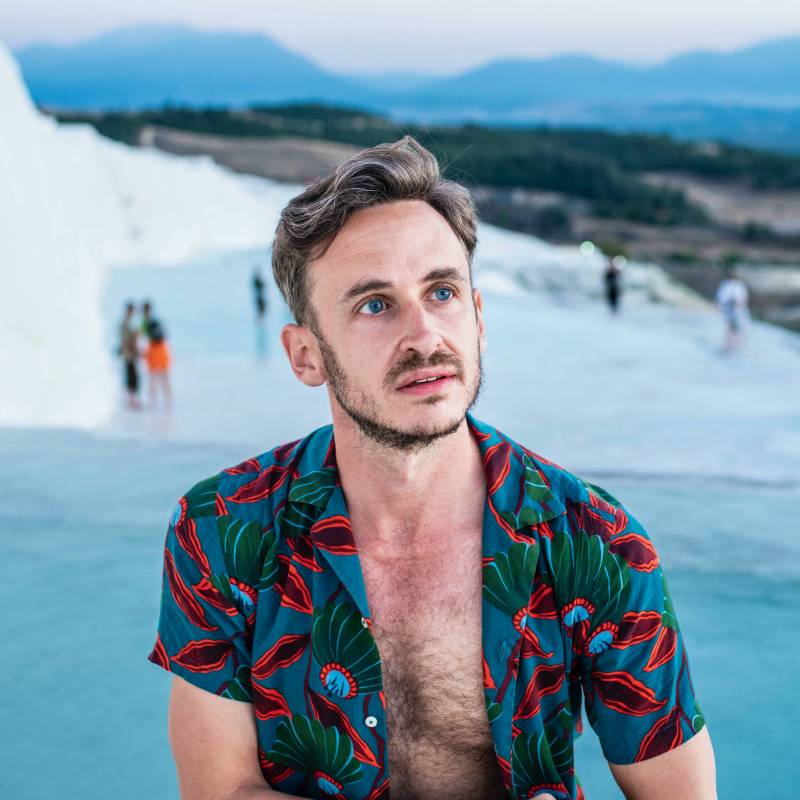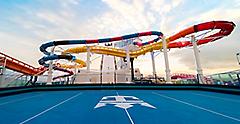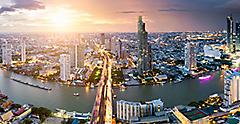
Bangkok, whose Thai name "Krungthep Mahanakhon" roughly translates to "City of Angels," is the ultimate study in contrast. Between ancient temples and modern skyscrapers live humble day-laborers and high-rolling billionaires. The city is a current of chaos that will overload your senses to the point of numbness, not unlike the Thai chili peppers in your pad krapow gai (stir-fried chicken with holy basil). Bangkok is an exhilarating introduction to Thailand.
Although it's difficult to have an uninteresting time in Bangkok, you're always better off if you have an expert guide with secrets of the city up their sleeve — today, you're lucky enough to have me. Once you get to Bangkok, find your nearest BTS Skytrain station, make sure you have a pocket full of 10-baht coins for local transportation, and follow me.
Start At The River Of Kings

I always start a trip to Bangkok by riding the Skytrain to Saphan Taksin station. Then, I follow the signs down the staircase to Sathorn Pier. You might feel like you've made a wrong turn when you walk onto the humble, slightly ramshackle public boat, but trust me. Traveling up the Chao Phraya River — known in Thai as the "River of Kings" — is one of my favorite things to do in Bangkok, and not just because it circumvents the city's infamous traffic.
As the boat begins its journey northward, stopping every few minutes along the east or west bank to pick up more passengers, the cool breeze is as refreshing as the relative quiet of the river. Visually, too, the journey is soothing to the mind and soul, particularly when the boat rounds the first bend and the golden temple spires of Bangkok's Old City come into focus.
I usually get off at Memorial Bridge, known in Thai as Saphan Phut, then walk west across it into the lesser-visited Thonburi side of the city. Starting at the Wat Prayun white temple — whose resident turtles are a popular attraction for local children — I walk along a riverside path, which strings together the Portuguese-built Santa Cruz Church, the Guan Yu Shrine and Wat Kalayanamitr, a traditional Thai temple made all the more satisfying by the utter lack of tourists. After sitting beneath the giant, golden Buddha to cool off (it's always hot in Bangkok), I typically follow the locals and sound the massive gong just outside the main hall.
Then, I hop on a tuk-tuk auto rickshaw northward to the Wat Arun "Temple of Dawn," which is a much more typical place for travelers in Thailand to visit. If the stairs are open, I climb to the top of the stupa — which was recently renovated in 2018 — and look across the river to Rattanakosin. The heart of Bangkok's ancient city, this is where the seat of royal Thai power has resided for more than 300 years.
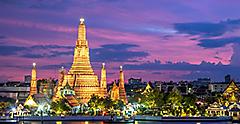
Say A Prayer In Rattanakosin
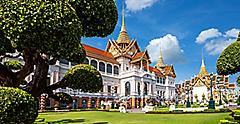
Conveniently, you can ride a ferry directly across the Chao Phraya from Wat Arun. It costs just 5 baht (around 15 cents) and takes only a couple of minutes. Just outside the ferry exit, street vendors sell delicious bites like cha yen (Thai-style iced tea with milk) and sweet khanom krok coconut dumplings. If I'm not hungry, I'll skip the snacks and walk directly into Wat Pho, the temple of the reclining Buddha.
No matter how many times I visit this awesome place, or how wide the gulf between Thai and tourist ticket prices has become, the massive size of the reclining Buddha (and "reclining" next to it for a photo-op) is always an amazing experience. If you have some extra change with you, do as the locals do and drop a coin in each of the small pots to the right side of the hall as you walk through (the statue is on your left). Make sure not to accidentally drop your shoes — which you carry in a plastic bag an attendant gives you — into one of the pots!
At the end of a long day exploring Bangkok, a massage is a must. To the surprise of many people, you can actually get one at Wat Pho, where a local massage school operates. If you don't avail this, go out the back exit of the temple, and then head up Sanam Chai Road to the famous Grand Palace and Temple of the Emerald Buddha. If you aren't down to pay the high entrance fee to become part of the large crowds swarming it, you can marvel at it from a grassy spot at Sanam Luang Park.
I, on the other hand, usually head farther north into Rattanakosin. On some days I'll ascend the aptly named "Golden Mountain," a temple set atop a manmade hill that offers amazing views, especially at sunset. On other days, I'll head north toward the Khao San Road backpacker area but stop just short of it for a break. Call me crazy, but I prefer sitting beneath the rows of golden Buddhas at Wat Suthat than amid the drunken passers-by at Khao San.
Chinatown: Cultural And Culinary Delights
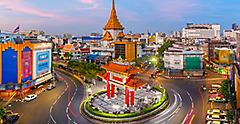
Much love to my fellow "farang" (the Thai word for foreigners, sometimes used pejoratively), but I prefer to spend my evenings in Bangkok amid a more local crowd. For this, a tuk-tuk takes me right to Bangkok's Chinatown, called Yaowarat. Yaowarat is as famous for its iconic neon signs as it is the Thai and Chinese fusion cuisine sold by the hundreds of vendors that line the streets.
People line up for hours to enjoy the crab omelets Netflix-famous and award-winning chef Khun Jay Fai makes. Her kai jiew puu is delicious, but there are some hidden gems here worth checking out. If you don't mind eating at pink or red plastic tables set right in the middle of the street, open-air seafood restaurants like T & K and Rut & Lek are a great bet. Here, I usually go big and go simple, with the massive grilled prawns washed down with a Chang or Singha Thai beer.

If you want air-conditioning (or at least the promise of it) and prefer something more Chinese, the dim sum on offer at either the modest Canton House or the more upscale Red Rose, which is located inside a boutique hotel, might be more to your taste. No matter what your main course comprises, I recommend finishing the evening with some Pa Tong Go. You can grab these Chinese-style fried doughnuts from any of the dozens of sellers assembled along Yaowarat Road.
I like to round out the evening with a stroll past the famous Chinatown Gate and the "marble temple" of Wat Traimit, ending at Hualamphong, where I can easily ride the underground MRT back to wherever I'm going in the city. Note that while Hualamphong Train Station itself has been decommissioned, the historical early 20th-century facade is still worth taking a moment to marvel at, particularly when it lights up at night.
Bangkok's Many Downtowns

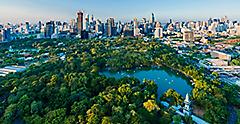
Arriving back to the station (I usually head for Saladaeng, even if I arrived at Chong Nonsi), I make one of two decisions. Sometimes, I skip the train and instead walk across the sky bridge and down into lush Lumphini Park, Bangkok's answer to Central Park — but with massive monitor lizards instead of pigeons. Other times I'll ride the Skytrain to Siam, where I can spend an entire morning shopping in malls like Siam Discovery, Siam Center, Siam Paragon and CentralWorld.
There are a couple of things you should know here. First, the pad thai on offer in the basement food court of Siam Paragon is to die for. Yes, I know it's a mall, but trust me: Even the locals swear by it! Secondly, as you're walking across the sky bridge from CentralWorld to Chit Lom Station, be sure to look down and to your right for an astonishing perspective of the Erawan Shrine.
Then, I'll buy a ticket and enter Chit Lom station, head down the escalator and walk farther down Sukhumvit Road to experience some nightlife. When the sun goes down, Bangkok comes alive. Nightlife is part of the allure of traveling in Thailand, and within the many "downtowns" of Bangkok including Sathorn, Silom and Sukhumvit, you'll have plenty of options. If you stick to the Sukhumvit area, visit the rooftop bar of RedSky at CentralWorld, or the wilder Soi Cowboy near Asok Station. In Silom, meanwhile, Soi 4 is one of Bangkok's gay hubs, while raucous Patpong Night Market caters to a broader range of partygoers. For a nightcap, ride to Saphan Taksin and ascend the Lebua Tower's rooftop for cocktails and stunning views of both lobes of Bangkok — the river and old city on your left (looking north), and the sleek modern skyscrapers of Bangkok's many downtowns to your right.
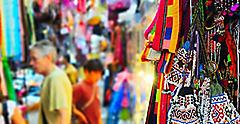
Follow In My Footsteps For Your Thailand Vacation
Traveling in Thailand usually starts in Bangkok, but it almost never ends there. I hope, by following along with me through Thailand's capital, you're inspired to dig deeper and travel thoroughly, no matter where you go in the Kingdom. And I hope that in following my suggestions for destinations and experiences, you happen upon the intangible amazingness that led me to call Bangkok home for more than two years. The motorcycle taxi that makes a wrong turn, passing by a towering Buddha or gleaming golden stupa you can't help but get off and explore. The luck to be invited out by a group of local strangers when your travel buddy stands you up for happy hour. Arriving to a popular restaurant after closing time, only to have the master chef who runs the place whip you up something off-menu, which ends up exceeding your wildest expectation.
And as for the rest of Thailand? For some travelers, the onward journey will entail heading to more typical destinations, such as the dense jungles of northern Chiang Mai province, or the breathtaking beaches down south in Krabi or Phuket. Others will head northeast to off-the-beaten-path Isaan or west from Bangkok into Kanchanaburi, rich with riverine scenery and World War II-era heritage. No matter what form your trip to Thailand takes, bring your curiosity, your sense of adventure and a healthy appetite!
Get Royal Deals, Sign Up Today

Getting There
Explore Our Most Affordable Itineraries
Uncover the best things to do in Bangkok for making the most of your cruise vacation in Thailand.

